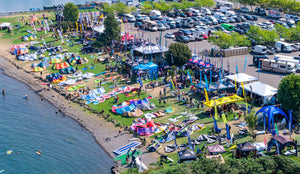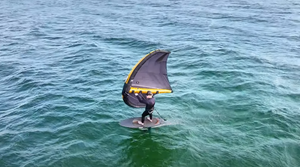Why I Fell in Love with Mid-Length Foil Boards: A Rider's Journey
Feb 09, 2025
Like many of us in the foiling community, I started my journey as a kiter. The transition to winging was a game-changer – suddenly, I was free from the constraints of wind direction, complex launches, and all that gear. But it wasn't until I discovered mid-length boards that I truly found my groove in the water. Let me tell you why.
The "Aha" Moment
Remember that feeling when you first got up on foil? That magical moment when everything clicks, and you're literally flying above the water? Well, switching to a mid-length board felt like that all over again. Here's the thing about mid-lengths that nobody told me at first: they're not just longer boards – they're gateways to a whole new style of riding.
Breaking Free from the Short Board Mindset
I used to think shorter boards were always better. More maneuverability, easier to transport, better for tricks – that's what everyone said, right? But here's what changed my perspective: I realized I was spending too much time worrying whether I had enough power (wing vs wind) to have a good session than actually enjoying the ride. And don't get me started on the wing size dilemma – you know, when you have to grab that bigger wing just to get your short board out of the water and up on foil, only to find yourself massively overpowered once you're riding. Or even worse, you're stuck sitting in the water watching everyone else having fun because you can't generate enough power to get up on foil.
Mid-length boards taught me something different. They showed me that there's a sweet spot where performance meets versatility, where you can stop worrying about your equipment and start focusing on what really matters – the pure joy of gliding over the water. Their efficient design means you can often use a smaller wing, getting the power you need for takeoff while maintaining control once you're up and riding.
"more tai chi than kung fu"
But it's more than just equipment – it's a complete shift in riding philosophy. Moving from the aggressive pursuit of speed and bigger jumps to something more flowing and graceful. It's about becoming one with the rhythm of the ocean or river, more tai chi than kung fu, carving elegant turns down the face of a wave. In many ways, it's discovering what surfers have known for generations, but with an amazing bonus: our rides can go on and on and on.
The Light Wind Revolution
Let's talk about those frustrating light wind days. You know the ones – when you're watching the forecast, hoping for just a few more knots of wind. This is where mid-lengths truly shine. Their longer, narrower profile means you can get up and riding in conditions that would have kept you beach-bound before. It's like having a secret superpower that turns marginal days into epic sessions.
"It's like trying to pat your head and rub your stomach while doing a squat workout!"
But here's what really sets them apart: the takeoff efficiency. If you've ever ridden a typical wing board in light winds, you know that exhausting dance – the coordinated pumping of feet and hands, trying to generate enough forward speed while simultaneously breaking surface tension, all while maintaining your balance. It's like trying to pat your head and rub your stomach while doing a squat workout!
Mid-lengths are completely different. They take off more like an aircraft – smooth, controlled, and surprisingly effortless. The long, narrow shape naturally generates forward speed with minimal effort, and then all it takes is a gentle shift of pressure to your back foot, and the nose starts to rise. Before you know it, you're gliding out of the water with none of the frantic energy expenditure.
The Waka Glide has a bit of extra magic in its design here. We've engineered a specific front-to-rear volume distribution – approximately 52% in the front and 48% in the rear – combined with a forward foil placement for the rider. This creates a slight natural launch posture when the board is floating, similar to how an airplane's nose wheel lifts first during takeoff, even before it has reached full flying speed. This subtle but intentional design feature dramatically improves launch efficiency by reducing the energy needed to break free from the water.
This efficiency isn't just about making your life easier (though that's a nice bonus). It means you can get up on foil in lighter winds, stay riding longer, and spend less time in that vulnerable transition between water and flight. It's game-changing stuff.
Why It's Not Just About Length
Here's what makes mid-lengths special – they're not just stretched-out versions of shorter boards, and they're definitely not shortened downwind boards either. They're something entirely unique: an ingenious blend of the best technologies and design principles from across the foiling spectrum. Think of them as the "greatest hits album" of board technology, taking the most effective elements from wing boards, downwind boards, and surf foil boards to create something that transcends all these categories.
Let's talk about shape and volume distribution, because this is where the magic really happens. Notice that shark-like profile? That's no accident. This surfboard-inspired design does two crucial things: it helps the board accelerate more efficiently by minimizing water contact, and it actually reduces swing weight by concentrating volume closer to the foot pad area rather than the nose. Compare that to traditional square-nosed wing boards, and you'll feel the difference immediately in how the board handles.
Here's where things get really interesting with volume distribution. Some brands are marketing "mid-length" boards that are proportionally short - for example, a 100L board that's only 6'3" long but quite narrow at 18-19". To achieve this volume in a shorter length, they need to make the boards quite deep, sometimes over 6 inches in depth. We disagree with this approach. Here's why: when you pack that much volume under a smaller surface area, you end up with a fundamentally unstable board. Even worse, in choppy conditions, that deep volume without sufficient length creates a pitching motion that can make riding feel like you're on a seesaw. That's exactly why we designed the Waka Glide on the longer end of the mid-length spectrum – it gives you the perfect balance (literally) of stability and performance.
Let's talk about width too – because this is where things get really interesting. Take the Glide 99 for example. With a waist just over 21 inches, it's significantly narrower than comparable volume wing boards that might span 24-29 inches. Now, your first thought might be, "Won't that make it less stable?" And sure, if you were standing still on the board like it's a yoga mat, you'd be right. But here's the magic: these boards are designed for motion.
The moment you catch even a moderate puff of wind, the board wants to move forward. That forward momentum, combined with the longer length, creates its own form of dynamic stability. You're not fighting the short-board pitch and wobble – instead, you're working with a board that wants to track and glide. And here's where that narrow waist really shines: when you're carving turns or driving upwind, you've got significantly more room to lean the board over without catching a rail in the water. Try doing that with a wider board, and you'll quickly find yourself making unwanted contact with the surface.
The design philosophy is completely different from anything that came before. Rather than compromising or just modifying existing designs, mid-lengths represent a fresh approach that delivers high performance, effortless glide, and versatility in one thoughtfully engineered package. It's not a compromise; it's a culmination of everything we've learned about what makes a great foil board.
The Sweet Spot for Wave Riding
For those of us who live for the feeling of connecting waves and riding swells, mid-lengths are a revelation. The extra length gives you this incredible stability and glide that makes linking waves feel natural and intuitive. Whether you're cruising mellow swells or charging bigger waves, the board works with you, not against you.
Beyond the Beginner Board
Mid-lengths are often the board of choice for more intermediate to advanced riders who understand that true performance comes from efficiency and versatility, not just going shorter and smaller. These riders have moved past the "shorter is better" mindset and discovered that a well-designed mid-length allows them to access a higher level of performance across a wider range of conditions.
The One-Board Solution?
Could a mid-length be your one-board solution? For many riders, including myself, the answer is yes. Here's why: they handle light wind days with ease, perform beautifully in waves, and still maintain enough maneuverability for when you want to get playful. It's like having multiple boards in one.
Finding Your Perfect Match
If you're considering making the switch to a mid-length, here's my advice: think about your riding style and goals. Are you all about maximizing your time on the water? Do you love the feeling of flowing from wave to wave? Are you tired of being limited by conditions? If you answered yes to any of these, a mid-length might be your perfect match.
"volume is your friend"
And here's something that might surprise you – when it comes to the Waka Glide, we actually embrace a "volume is your friend" philosophy. I know, I know, the conventional wisdom has always been to size down, to go for the smallest board you can handle. But here's the thing: choosing a Glide with more volume than your current board isn't just about making life easier – it's about future-proofing your sessions.
Think about it: the foiling world is exploding with innovations, especially in light wind power sources. Parawings are just the beginning; we're seeing new variations and technologies coming to market all the time. Having that extra volume means you're not just buying a board for today's conditions and style – you're investing in the flexibility to explore all these exciting new possibilities as they emerge. It's like having a board that's ready for the future before it arrives.
Plus, let's be honest – when was the last time you regretted having too much float in light wind? Extra volume is like having an insurance policy for those marginal days when everyone else is sitting on the beach.
Looking Ahead
The future of foiling is exciting, and mid-length boards are playing a huge role in shaping that future. They're pushing the boundaries of what's possible, making the sport more accessible and enjoyable for riders of all levels.
Final Thoughts
At the end of the day, the best board is the one that gets you out on the water more often and brings the biggest smile to your face. For me and many others, that's a mid-length. And here's the really exciting part – thanks to innovations like the Waka Glide's folding technology, you no longer have to choose a shorter board just because it's easier to transport. That artificial constraint is gone. You can finally select your board based purely on how it performs and feels on the water, not how it fits in your car or on the plane. It's not just about the length of the board – it's about the freedom it gives you to express yourself on the water, to progress at your own pace, and to make the most of every session.
Whether you're coming from a shorter board or looking to progress from your beginner setup, give mid-lengths a chance. They might just change your perspective on what's possible in foiling, just like they did for me.
Remember, the goal isn't to ride the smallest board possible – it's to have the most fun possible.
And in my experience, mid-lengths deliver that in spades.
See you out on the water!





